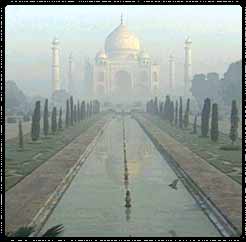|
|
 The
construction of this marble masterpiece is credited to the Mughal
emperor Shah Jahan who erected this mausoleum in the memory of his
beloved wife, Arjumand Bano Begum, popularly known as Mumtaz Mahal, who
died in AH 1040 (AD 1630). Her last wish to her husband was "to
build a tomb in her memory such as the world had never seen before".
Thus emperor Shah Jahan set about building this fairytale like marvel.
The
construction of this marble masterpiece is credited to the Mughal
emperor Shah Jahan who erected this mausoleum in the memory of his
beloved wife, Arjumand Bano Begum, popularly known as Mumtaz Mahal, who
died in AH 1040 (AD 1630). Her last wish to her husband was "to
build a tomb in her memory such as the world had never seen before".
Thus emperor Shah Jahan set about building this fairytale like marvel. The construction of Taj Mahal was started in AD 1631 and completed at the end of 1648 AD. For seventeen years, twenty thousand workmen are said to be employed on it daily, for their accommodation a small town, named after the deceased empress-'Mumtazabad, now known as Taj Ganj, was built adjacent to it. Amanat Khan Shirazi was the calligrapher of Taj Mahal, his name occurs at the end of an inscription on one of the gates of the Taj. Poet Ghyasuddin had designed the verses on the tombstone, while Ismail Khan Afridi of Turkey was the dome maker. Muhammad Hanif was the superintendent of Masons. The designer of Taj Mahal was Ustad Ahmad Lahauri. The material was brought in from all over India and central Asia and it took a fleet of 1000 elephants to transport it to the site. The central dome is 187 feet high at the centre. Red sandstone was brought from Fatehpur Sikri, Jasper from Punjab, Jade and Crystal from China, Turquoise from Tibet, Lapis Lazuli and Sapphire from Sri Lanka, Coal and Cornelian from Arabia and diamonds from Panna. In all 28 kind of rare, semi precious and precious stones were used for inlay work in the Taj Mahal. The chief building material, the white marble was brought from the quarries of Makrana, in distt. Nagaur, Rajasthan.


